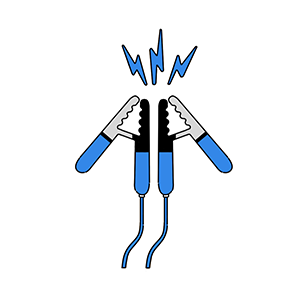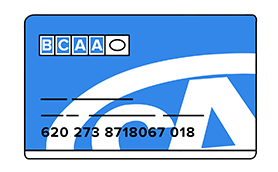Winter driving emergency kit—what gear to carry in your car
To help keep you safe, here’s a list of winter driving items that BCAA Auto Service Experts suggest drivers carry in their cars in addition to your BCAA Membership card:
Winter driving equipment
- Roadside emergency kit. You can get a pre-made kit at a retail store which typically includes a reflective safety vest, reflective roadside equipment such as cones and battery jumper cables.
- Windshield scraper, snow brush and shovel. Remove snow, ice and dew from all of your car windows and side mirrors to ensure you can see clearly while driving. Make sure to remove all the snow off the top of your car and clear your front and back lights. A shovel can come in handy to get your car out of some snowy situations.
- Salt or other traction aid. Appropriate road salt and even appropriate road salt or even wood chips can help when your vehicle needs some traction on snow or when it’s icy.
-
 Booster cables. Battery problems is one of the most common reasons why BCAA is called on for help. It’s good to have booster cables in your car rather than hoping another driver or helpful citizen is carrying their own cables.
Booster cables. Battery problems is one of the most common reasons why BCAA is called on for help. It’s good to have booster cables in your car rather than hoping another driver or helpful citizen is carrying their own cables. - A jug of antifreeze. This keeps the radiator from freezing or overheating. If your antifreeze is running low or you run out, you may find yourself in trouble as well as causing damage to other parts of your car. Newer cars may have an automatic engine cut-off feature when its antifreeze is low which is designed to prevent your car from running in order to prevent additional damage.
- Spare container of winter-grade washer fluid. You don’t want to run out of washer fluid, especially if you’ll be driving longer distances and in areas where it’s not easy to find a gas station or automotive shop. If you run out, you won’t be able to keep your windshield clear of rain, snow and splashing from other cars, and it would be unsafe for you to drive.
- Winter tire chains. If you’ll be driving through snow-bound mountain passes, carry correctly sized tire chains for your tires. Some retail stores allow you to try the chains out in their parking lot to ensure they fit. Practice installing the chains when you’re at home, so you don’t have to figure it out at the roadside.
Emergency items
- Flashlight with extra set of batteries. In case you experience a vehicle problem when it’s dark.
- Mobile phone car charger or a portable battery charger
- Highly visible winter outerwear (i.e. warm clothes, winter boots, gloves and reflective vest) in case you have to get out of your car.
- Blanket and supply of non-perishable food and water. There may be times when you have to wait for assistance. Harsh weather, poor road conditions and even traffic can make it difficult for someone to arrive at your location to help.
- First-aid kit. Be sure to include personal prescriptions if necessary.
Driving aids
- A pair of sunglasses. When it's sunny, the glare from icy or wet roads can be blinding.
- Keep de-icing spray handy (outside of your car). Commercially-available de-icing spray is effective on frozen car locks. Carry a small bottle with you and keep extras at home and at the office. Remember, you won’t be able to access the de-icing spray if it’s kept in the glove compartment when your car locks freeze over.
- Keep your gas tank topped up. Ensure your vehicle has more than half a tank of gas at all times.
Use your BCAA Membership
Head online and use your BCAA Membership and save 20% on select emergency kits for home and vehicle use at our Rewards Partners, F.A.S.T. (First Aid & Survival Technologies Limited). Learn more about F.A.S.T. and get more information here.
For faster access to 24/7 emergency roadside assistance, submit your request using the BCAA Mobile App. You can also submit your request directly online at bcaa.com or by phone:
 |
|







